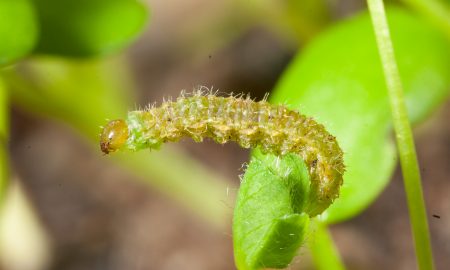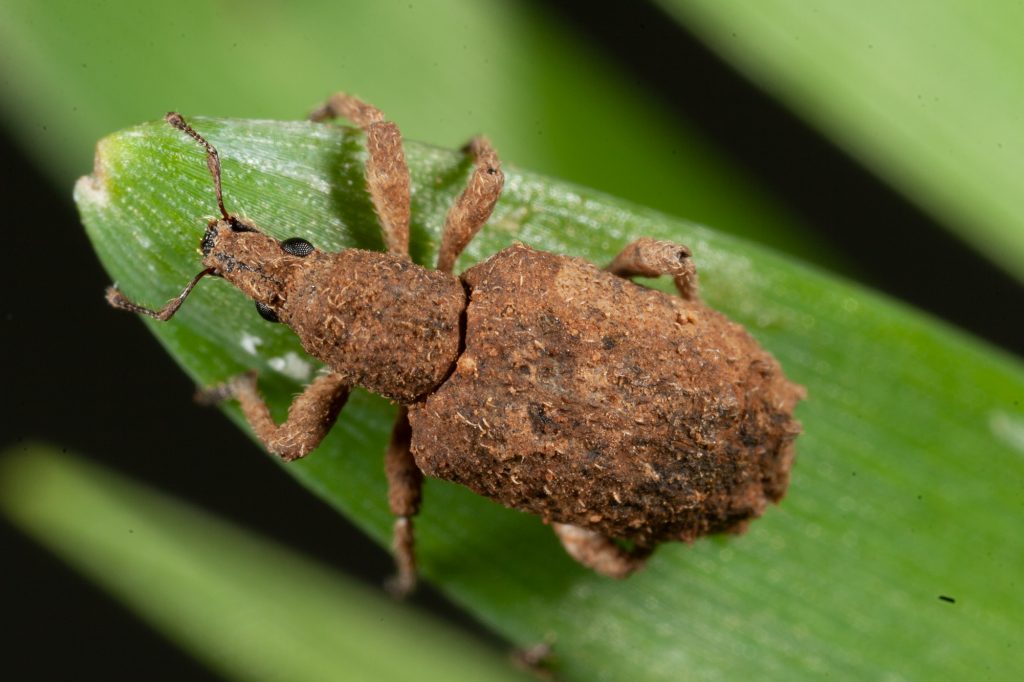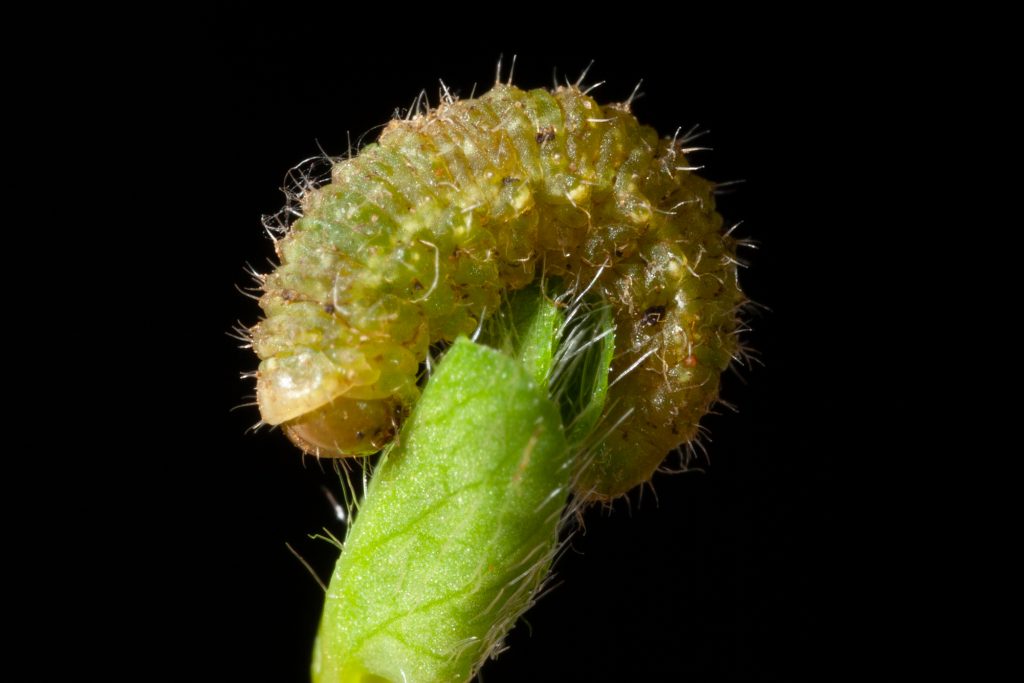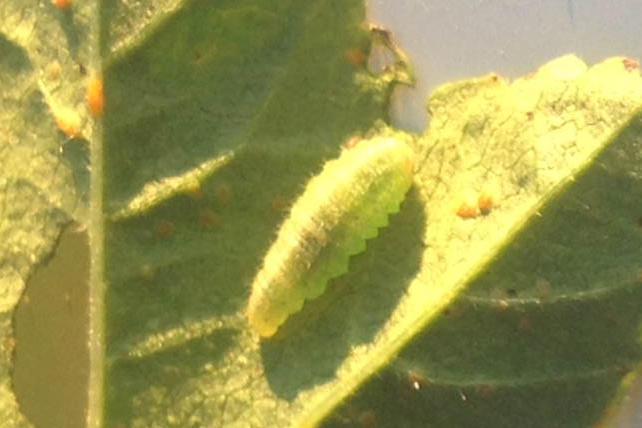Greybanded leaf weevil
Ethemaia sellata

Photo by Andrew Weeks, Cesar Australia
Summary Top
Greybanded leaf weevils are a sporadic pest of canola and lupins. The grub-like larvae are commonly found in high numbers on marshmallow weed.
Occurrence Top
Greybanded leaf weevils are sporadic pests that have a widespread distribution in eastern Australia. They have been reported across the southern cropping region in New South Wales, South Australia, Victoria and Tasmania.
Greybanded leaf weevils have been reported in New South Wales, South Australia, Victoria and Tasmania.
Description Top
The adult weevils are approximately 8 mm long and light brown-grey in colour. They have distinctive raised markings (bumps) and a paler colour banding on the rear of the abdomen, covering approximately 1/4 of the elytra (wing covers). Adults are thought to be flightless. Larvae of the greybanded leaf weevil are legless, up to 5 – 8 mm long and yellow-green in colour with a darker coloured head.


Lifecycle Top
Little is known about the lifecycle of greybanded leaf weevils. Eggs are laid on plant leaves, after which the larvae emerge in autumn/winter and feed on plant leaves before pupating in the soil.
Behaviour Top
Because larvae are legless, natural dispersal can be slow. However, greybanded leaf weevil adults and larvae have a tendency to move into crops from weed hosts growing along fence lines that die off after herbicide applications. Larvae are often observed feeding on plant foliage.
Similar to Top
Adults are similar to other weevils, including the vegetable weevil and spotted vegetable weevil. Larvae are similar in size and colour to vegetable weevil larvae.
Crops attacked Top
Canola and lupins. Malvaceous weeds such as marshmallow are also a favorable host plant.
Damage Top
Typical weevil damage includes leaf scalloping, chewing of leaf edges and thinning of plants. In severe cases, canola cotyledons can be completely chewed off at ground level. Weed hosts such as marshmallow can be severely defoliated.

Monitor Top
Check crops during establishment, especially near fence lines and areas in paddocks where marshmallow weed is present or was growing prior to sowing. Shot holes in the leaves of marshmallow plants are a key indicator of the presence of greybanded leaf weevil larvae.
Economic thresholds Top
There are no economic thresholds established for this pest.
Management options Top
Biological
There are no known biological control agents for greybanded leaf weevils.
Cultural
Control summer and autumn weeds, particularly marshmallow, to reduce the availability of alternate hosts between growing seasons.
Controlling summer/autumn weeds near crops, especially marshmallow weed, can reduce populations of grey-banded leaf weevils.
Chemical
There are no insecticides currently registered to control greybanded leaf weevils. There are field reports that suggest synthetic pyrethroids used at 400 mL/ha against other pests may also provide control of greybanded leaf weevil. Check the APVMA website for current chemical options.
Acknowledgements Top
This article was compiled at cesar by Alana Govender and Paul Umina.
References/Further Reading Top
Bellati J, Mangano P, Umina P and Henry K. 2010. I SPY Insects of Southern Australian Broadacre Farming Systems Identification Manual and Education Resource. Department of Primary Industries and Resources South Australia (PIRSA) and the Department of Agriculture and Food Western Australia (DAFWA).
Cribb M and Umina P. 2013. Crop Weevils: The Back Pocket Guide. GRDC and cesar.
| Date | Version | Author(s) | Reviewed by |
|---|---|---|---|
| February 2016 | 1.0 | Alana Govender (cesar) and Paul Umina (cesar) | Garry McDonald (cesar), Bill Kimber (SARDI) |
What are PestNotes?
PestNotes are information sheets developed through a collaboration between Cesar Australia and the South Australian Research and Development Institute (SARDI). Copyright: © All material published in PestNotes is copyright protected by Cesar Australia and SARDI and may not be reproduced in any form without written permission from both agencies.
Disclaimer
The material provided in PestNotes is based on the best available information at the time of publishing. No person should act on the basis of the contents of this publication without first obtaining independent, professional advice. PestNotes may identify products by proprietary or trade names to help readers identify particular products. We do not endorse or recommend the products of any manufacturer referred to. Other products may perform as well as or better than those specifically referred to. Cesar Australia and PIRSA will not be liable for any loss, damage, cost or expense incurred or arising by reason of any person using or relying on the information in this publication. Any research with unregistered pesticides or products referred to in PestNotes does not constitute a recommendation for that particular use.

